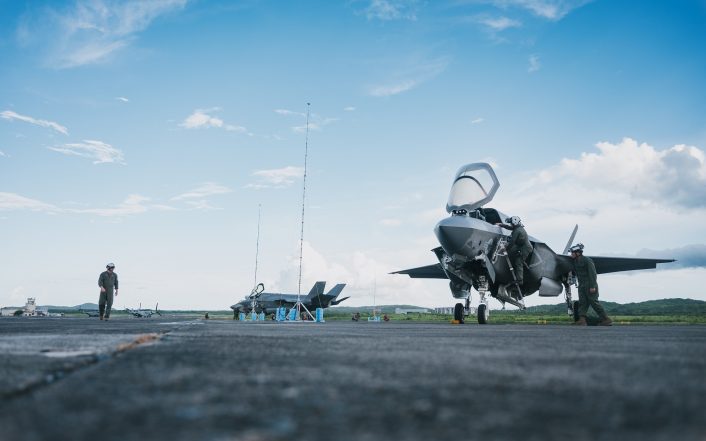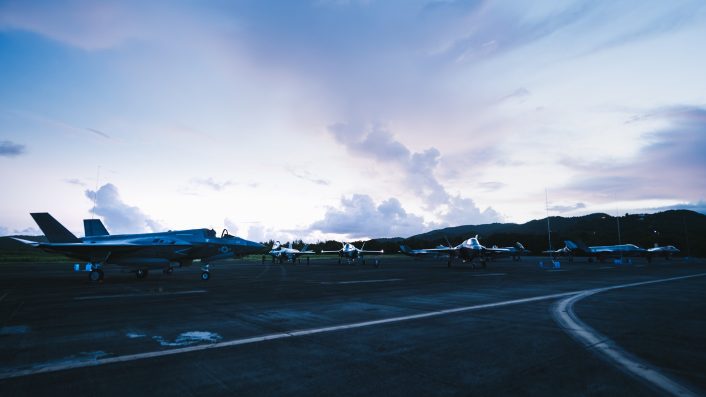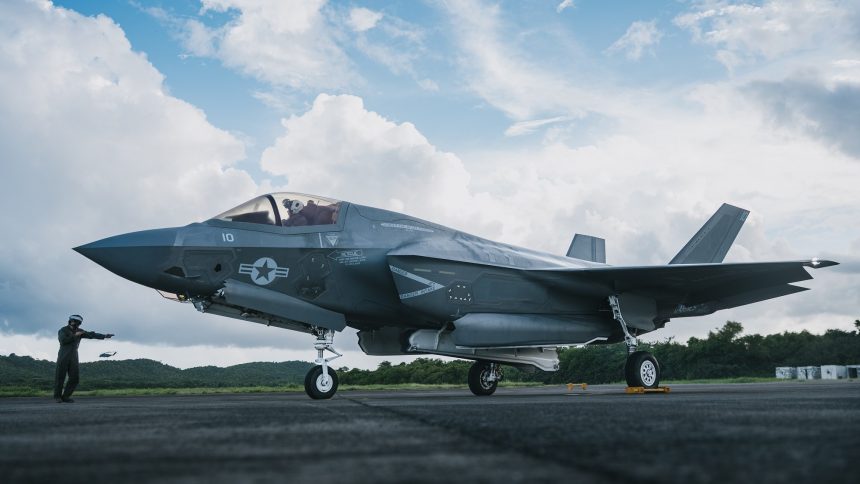Weeks after they arrived in Puerto Rico, the F-35s were shown flying with live AIM-120Ds, AIM-9Xs and GBU-54s.
The U.S. is now showing in official images the U.S. Marine Corps’ F-35Bs operating in the Caribbean, weeks after they were initially deployed to Puerto Rico. The first images were released on the DVIDS network on Oct. 2, 2025, although they were captured on Sept. 13 – the day the F-35s arrived at the former Roosevelt Roads Naval Station in Ceiba, Puerto Rico.
Armed F-35s
Notably, on Oct. 3, the U.S. Southern Command (SOUTHCOM) released a video showing the F-35Bs being armed and launched with live weapons. While only one is shown during the loading operations, several aircraft can be seen already armed in the background.
Lethality and warfighting:#Marines load ordnance on @USMC F-35B Lightning II fighters during training in the Caribbean. U.S. forces are deployed to the Caribbean in support of the #SOUTHCOM mission, @DeptofWar-directed operations, and @POTUS’ priorities. @SecWar @MARFORSOUTH pic.twitter.com/SBmFtmVcK4
— U.S. Southern Command (@Southcom) October 3, 2025
The aircraft are carrying a mix of two AIM-9X Sidewinder IR-guided air-to-air missiles – carried externally, an AIM-120C-6 and an AIM-120D AMRAAM radar-guided air-to-air missiles, and two GBU-54 Laser JDAM 500 lb guided bombs. The combination of weapons is interesting as U.S. President Donald Trump said he’s considering striking targets in Venezuela, after determining the United States is engaged in “a non-international armed conflict” with drug cartels.
The use of Laser JDAMs would give the F-35s the flexibility to engage both moving targets, like the vessels being struck at sea, as well as fixed land targets. Also, the combination of AMRAAMs and Sidewinders would allow the F-35s to counter the fighter jets of the Venezuelan Air Force (Aviación Militar Bolivariana Venezolana), the F-16s and Su-30s – the former only armed with AIM-9s and the latter also armed with the R-77 (AA-12 Adder) radar-guided AAM.
Earlier this morning, on President Trump’s orders, I directed a lethal, kinetic strike on a narco-trafficking vessel affiliated with Designated Terrorist Organizations in the USSOUTHCOM area of responsibility. Four male narco-terrorists aboard the vessel were killed in the… pic.twitter.com/QpNPljFcGn
— Secretary of War Pete Hegseth (@SecWar) October 3, 2025
Additionally, not all aircraft are equipped with the usual RCS (Radar Cross Section) enhancers/radar reflectors normally installed during peacetime and training operations. The aircraft are flying this way with their lowest radar signature, and this would allow them to take full advantage of their low-observable capabilities in the event of land strikes.
Several S-125 “Pechora-2M” Surface-to-Air Missile Systems with the Venezuelan Army were spotted on the Central Regional Highway yesterday near Maracay in Northern Venezuela. pic.twitter.com/dbXbNjWBxP
— OSINTdefender (@sentdefender) October 3, 2025
F-35s in Puerto Rico
The first flight of F-35B Lightning II stealth fighters arrived in Puerto Rico on Sept. 13, 2025, a week after it was originally announced. The 5th generation fighters joined the broader and visibly expanded U.S. military posture in the Caribbean that U.S. officials tie to counter-drug operations.
Photos and open-source tracking first showed F-35s landing at the former Roosevelt Roads naval complex in Ceiba, Puerto Rico. A Reuters photographer captured images of five F-35s touching down there on Sept. 13, while open-source tracking showed additional jets arriving from Marine Corps Air Station Yuma via MacDill Air Force Base.
Notably, the photographs of the F-35s landing at Ceiba showed the jets without visible unit tail and fuselage markings. The absence of clear identifiers has raised questions among observers, although it is being considered as a deliberate measure to enhance operational security and reduce attribution of the deployed jets to the units involved.
The captions of the photos now released identify the unit involved in the deployment as the Marine Fighter Attach Squadron 225 (VMFA-225), also known as the “Vikings.” The unit is indeed based at MCAS Yuma, Arizona.

The aircraft are shown parked in the open at Ceiba’s airport, surrounded by support equipment. Notably, multiple lightning rods can be seen on the flight line, a recurring feature seen for years when the fighters are deployed to contain safety issues due to lightning strikes.
It appears that the U.S. might be gearing for an expansion of the operations there, as other photos captured on Sept. 29 show ongoing repair and resurfacing works at Ceiba. The captions specifically mention “milling and overlaying a new runway” at the location.
What the F-35s Bring
Observers and analysts emphasize that the F-35’s value in the region extends beyond air-to-air combat. As we previously noted here at The Aviationist, the fifth-generation platform combines advanced strike capability with extremely capable sensors and data-fusion systems that make it a powerful nontraditional Intelligence, Surveillance and Reconnaissance (ISR) asset.
The aircraft’s AESA radar and electro-optical suites can collect and fuse information that is distributed across command networks, enhancing maritime and overland situational awareness in complex environments. This multiplies the effectiveness of any force package it supports, making the aircraft not only a deterrent through presence but also a force enabler that enhances situational awareness and operational decision-making in contested environments.

Significance
The display of U.S. Marine Corps F-35Bs armed with live ordnance in Puerto Rico comes at a time of heightened rhetoric between Washington and Caracas. Venezuelan President Nicolás Maduro has repeatedly accused the United States of preparing for military intervention, while U.S. officials have criticized Venezuela’s continued role as a hub for narcotics trafficking.
Venezuela also accused the U.S. of flying the F-35s 75 km off its coast, in what has been described as a “provocation.” On the other hand, the U.S. says is also conducting exercises in the area, including naval live fire.
Demonstrating readiness and lethality: @USNavy and @USMC forces conducted training, including a live-fire exercise with naval weapons systems, in the Caribbean Sea. U.S. military forces are deployed to the Caribbean in support of the #SOUTHCOM mission, @DeptofWar-directed… pic.twitter.com/33wANxUOOk
— U.S. Southern Command (@Southcom) October 2, 2025
Trump’s recent remarks about considering strikes on drug cartel infrastructure in Venezuela have added a role to these deployments. Although U.S. Southern Command frames its activities as part of enhanced counter-narcotics operations, the positioning of 5th generation fighters within rapid striking range of Venezuelan airspace has strong deterrent overtones.
The release of imagery showing the jets armed with AIM-120 and AIM-9X missiles, alongside precision-guided GBU-54 Laser JDAMs, underscores Washington’s ability to both challenge Venezuelan Air Force fighters and deliver pinpoint strikes on maritime or land-based targets. This would show the readiness to counter any threat after Venezuela shown its Su-30s flying in the area with Kh-31A (AS-17 Krypton) supersonic anti-ship missiles.
La AMB muestra sus cartas en su propaganda, en éste caso un Sukhoi Su-30 artillado con misil Kh-31. Al mando de uno de los Sukhoi va Cindi Caraballo, alias Katara. Parte del video data de al menos Mayo de 2024. pic.twitter.com/LTVcv0U74G
— 𝘼𝙧𝙧𝙚𝙘𝙝𝙤 (@Arr3ch0) September 15, 2025
Additionally, the deployment of F-35Bs to Puerto Rico provides a clear example of how the U.S. military is applying its Agile Combat Employment (ACE) doctrine in practice. ACE emphasizes flexibility, dispersion, and rapid mobility of advanced platforms, enabling combat aircraft to operate from a wider network of smaller or improvised bases rather than relying solely on large, established airfields.
The F-35B, with its short take-off and vertical landing (STOVL) capability, is particularly suited to this model. By operating from the former Roosevelt Roads Naval Station in Ceiba, Puerto Rico, the USMC demonstrates that these jets can be forward-deployed to austere locations – outside of exercises – with limited infrastructure while still maintaining high-end combat capability.
This model also aligns closely with how the Marine Corps envisions deploying its aviation assets in the Pacific theater, where dispersal and survivability are critical in the face of peer threats. Puerto Rico thus would serve not only as a strategic Caribbean outpost for counter narcotic operations, but also as a proving ground for expeditionary sustainment of 5th generation fighters.









